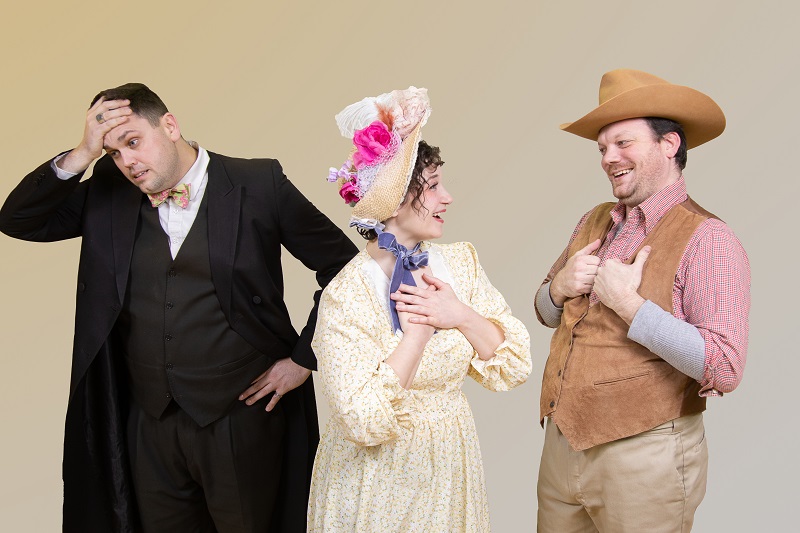“Oh, What a Beautiful” Evening Kelsey Theatre Offers with “Oklahoma!”; Colorful, Energetic Production Captures the Classic Musical’s Exuberance
“OKLAHOMA!”: Performances are underway for “Oklahoma!” Presented by Kelsey Theatre and Bear Tavern Project; and directed by Susan Galli, the musical runs through March 16 at Kelsey Theatre. Above: Ado Annie Carnes (Jessa Casner, center) must choose between itinerant peddler Ali Hakim (Pat Rounds, left) and cowboy Will Parker (Kevin Palardy, right). (Photo by Joe Cutalo Photography)
By Donald H. Sanborn III
Kelsey Theatre is continuing its “Season of Transformations” with Bear Tavern Project’s production of a classic show that transformed musical theater itself: Oklahoma!
Countless essays have been written about the 1943 show’s impacts on musicals as an art form, but perhaps the most immediately obvious and tangible one is that it launched one of the most successful and enduring collaborations in Broadway history: that of composer Richard Rodgers (1902-1979) and lyricist-librettist Oscar Hammerstein II (1895-1960).
Adapted from Lynn Riggs’ 1931 play Green Grow the Lilacs, the musical — set just after the turn of the last century, before Oklahoma became a state in 1907 — depicts the rivalry, between cowboy Curly and farmhand Jud Fry, both of whom vie to take farmer Laurey to a box social.
As a fundraiser for the construction of a schoolhouse, the women (with supposed anonymity) prepare baskets full of food on which the men will bid at auction. Each man spends the remainder of the party with the woman who prepared the basket he wins.
This deceptively simple plot masks themes of family (some male characters want to build one, while another goes out of his way to avoid it), class, and community — not to mention an unusually (for the time) deep psychological use of dance.
Hammerstein’s creative inclination — particularly with this show, and others written with Rodgers — is to be joyful until the plot gives him a reason not to be. Director Susan Galli and Choreographer Marissa Miller unreservedly support this, guiding the talented, enthusiastic cast and designers through an exuberant production that conveys the story in bright, bold colors.
This can be taken literally in the case of the lighting, designed by Joe Schiwall and TJ Buck. The colors of the lights change with the show’s mode, illuminating some of the romantic songs in pink, and the pithy confrontation scenes in red. (This device somewhat recalls the film adaptation of another Rodgers & Hammerstein musical, South Pacific, which used color filters to highlight different moods.)
The costumes (a collaboration between Kelsey Theatre, Town and County Players, and Neshaminy Valley Community Theater) pleasantly evoke the turn of the last century – or, perhaps more precisely, a theatrical conception of it. (Ado Annie’s delicate white dress and hat, punctuated by blue and pink ribbons, are especially attractive.) With exceptions, the color palette consists mostly of variations of red white, and blue, underlining the All-American aspect of the characters.
Joseph David Bryant brings smooth, jovial swagger and a sturdy baritone to the role of Curly. The brash but good-natured cowboy opens the show from behind the audience. He makes his way down to a stage that is bathed in orange light (for sunrise) as he delivers the unabashedly jubilant “Oh, What a Beautiful Mornin.’” The opening number establishes both the setting and the predominantly optimistic mood as Curly sings about corn “as high as an elephant’s eye.”
Bryant is equally entertaining in the bouncy “The Surrey With the Fringe On Top,” in which Curly boasts to Laurey about the carriage (which may or may not actually exist) in which he plans to take his date to the box social. The number is an example of the score’s attention to scenic detail; the rhythm imitates a horse’s hooves.
As the wholesome, acerbic farmer Laurey, soprano Sarah Blasenheim brings the required mixture of spunk and earnestness, as well as plenty of vibrato. The script has Laurey favor one suitor over another (at least privately), but it is to the performance’s credit that she appears to be genuinely torn for as long as it is plausible for the character to be.
The payoff for this comes in Laurey’s first-act finale, “Out of My Dreams,” in which Laurey sings about trying to decide which suitor she should choose: Curly, or farmhand Jud Fry. This expressive waltz is followed by the (well-choreographed and smoothly danced) “Dream Ballet” in which Laurey dreams about her predicament. A “Dream Laurey” (Alyssa Mills) is at her wedding, and finds that the groom is not who she expects.
To ensure consistent execution of the choreography, this sequence is accompanied by a pre-recorded orchestra. For the rest of the musical numbers, Music Director Joe Nappi ably conducts a smaller ensemble which, although unable to attain the lush sound of the original Robert Russell Bennett orchestrations, nonetheless is pleasantly crisp, with some especially attractive flute playing.
Vocally, Blasenheim is at her best in the breezy “Many A New Day,” a doth-protest-too-much number in which Laurey sings about not needing Curly or anyone else. (The song prefigures Nellie’s ““I’m Gonna Wash That Man Right Outa My Hair” from South Pacific.) The vocal segment of “Many a New Day” is followed by an elegant dance sequence that imitates ballerinas, in contrast to the raucousness of “Kansas City.”
Blasenheim’s and Bryant’s voices sound good together in their central ballad, “People Will Say We’re in Love,” as they bring just enough of a barbed edge to the wry lyrics that complement the lush but rhythmically brisk melody.
Suzanne Ardite is memorably sprightly as Laurey’s sassy but kindly Aunt Eller. The character is the first of many examples of a key Rodgers & Hammerstein archetype: the wise, maternal woman (the Mother Abbess in The Sound of Music is another memorable example).
As cowboy Will Parker, Kevin Palardy makes the wide-eyed “Kansas City,” in which Will marvels at “gas buggies” and seven-story “skyscrapers” with charming innocence, the high point (among many) that it needs to be. It is this number that Miller’s high-stepping choreography (literally) kicks into high gear, evoking (whether or not imitating) the original dances by Agnes de Mille.
Jessica Casner is outstanding as the amorously indecisive Ado Annie. Her pleasing mezzo-soprano and coquettish delivery make “I Cain’t Say No!” is another highlight. Palardy and Casner are charming in their second-act duet “All Er Nothin’”. Steve Wolfe is suitably gruff as Andrew Carnes, Ado Annie’s protective father.
Pat Rounds, who appeared in Kelsey’s production of Bright Star last season, is entertainingly oily as Will’s rival for Ado Annie’s affections: the (commitment-avoiding) itinerant peddler Ali Hakim. Olivia DePasquale is amusing as the giggly Gertie Cummings.
It is the conflict between Curly and Jud that leads Oklahoma! to take a darker turn. One of the most interesting performances is that of J. Ryan Harmer, who plays Jud. The burley, chip-on-the-shoulder farmhand often is portrayed as perpetually growling and seething, ready to erupt at any moment. Harmer, by contrast, plays Jud as a man of increasing desperation to claim the life (and woman) he perceives as being snatched from him – but who keeps his building resentment contained reasonably well — until he finally snaps.
Scenic Designer Shawn Simmons places the dark smokehouse, where Jud lives, off to the side of the stage – a prudent choice, as the script needs the audience to forget about the character for a few scenes. This is an apt metaphor for how Jud perceives his treatment at the hands of those around him.
This is a perception that Curly uses to goad Jud. In “Pore Jud is Daid,” Curly suggests that Jud could hang himself, after which mourners would come from “miles around.” Conceptually, the scene feels tasteless today, but Bryant and Harmer play off of each other well as they deliver the morbidly caustic lyrics.
Harmer gives Jud’s subsequent solo, the pithy “Lonely Room,” the intensity and vocal power it requires. The lyrics, which vividly describe a creaking floor and a mouse “a-nibblin’ on a broom,” are a bitter inverse of “Oh, What a Beautiful Mornin.’’
Fight Coordinator Dustin Karrat brings requisite action and suspense to the scenes in which the conflict between Curly and Jud escalates to trading more than barbs. (Audiences familiar with only the 1955 film may be startled by the stage show’s slightly different rendering of the climactic confrontation.)
The cast is ably rounded out by Jillian Alexander (Armina), Rachel Ash (Aggie), Chris Boerner (Ike Skidmore), Emmanuel Ebba (Slim), Frank Gramlich (Sam), Laney Kenwood (Sylvie), Joseph Perignat (Cord Elam), Alexis Plexico (Vivian), and Travis Weaver (Fred); with ensemble members Guiseppe D’Argenio, Nicandro D’Argenio, Megan Gramlich, Juliana Penney, and Amanda Zadroga-Cantada.
Nappi and Sound Designer Madelyn Weitkunat deserve credit for the ensemble’s consistently pleasing and well-balanced sound. The female chorus are lovely when they back up Laurey in “Many a New Day” and “Out of My Dreams;” and the general ensemble makes both the second-act opener “The Farmer and the Cowman” (which begins affably and turns wry as tensions erupt), and the rousing, celebratory title song, into the tour de force each number needs to be.
Notwithstanding the show’s darker scenes, the original Broadway production of the largely optimistic Oklahoma! must have been a refreshing contrast to the reality of World War II. Similarly, audiences likely will find Kelsey’s presentation to be a welcome respite from current headlines. Given that the story predominantly is about community, it is fitting that the Princeton area community has an opportunity to enjoy a live production of this classic musical.
“Oklahoma!” will play at the Kelsey Theatre at Mercer County Community College, 1200 Old Trenton Road in West Windsor, through March 16. For tickets, show times, and further information call (609) 570-3333 or visit kelsey.mccc.edu/shows_current.shtml.


